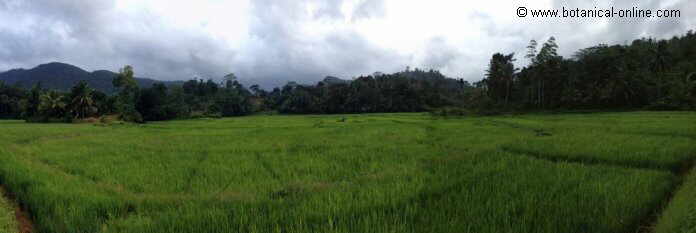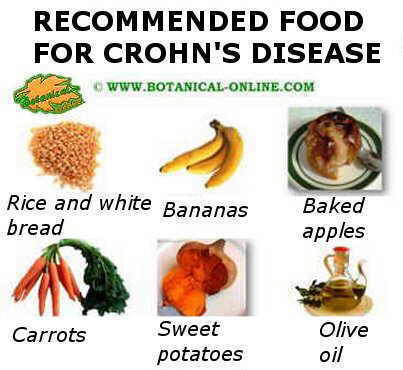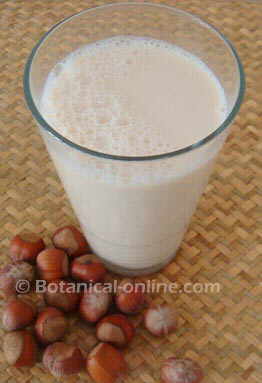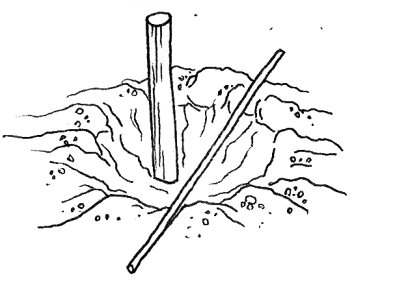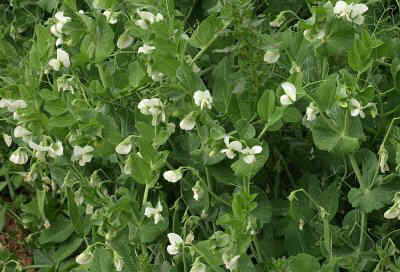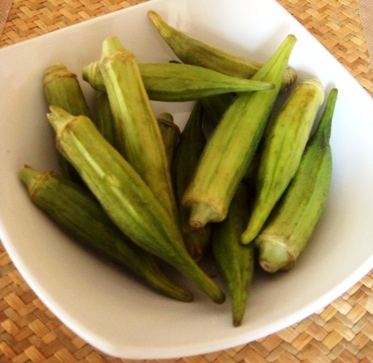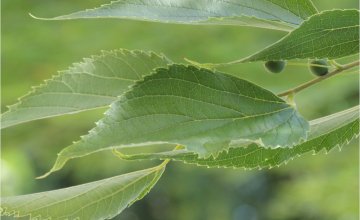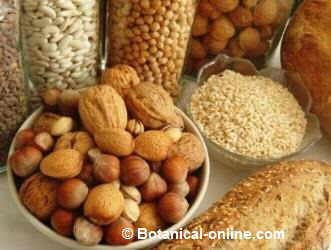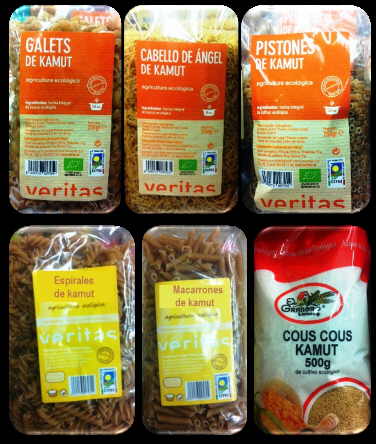Contents
PRODUCTION AND TYPES OF RICE
Cultivation and harvesting of the rice
Rice can be grown of four different ways:
– Flooded crops: Those that are made with the plant immersed in water. They need to have water current or being in places with abundant rainfall. The land is divided into parcels that are flooded and where planting is usually done by hand. The water level can vary from 25 cm to 5 m, which will require the use of different varieties. The productions flooded in surface shallow or deep water (from 25 cm to 1 m) often occur in African countries and on the island of Madagascar, where they are the most important source of food.
Flooded crops in Deniyaya, Sri Lanka
– Deep water rice: The rice crops are found in deep areas where water can reach up to five meters. Unlike the previous model there is no fragmentation of land since it prevents the continuous flooding. Planting is done with seeds and the plant have s scattered stems with very elongated spikes which float above water. This type of cultivation is carried out in areas like Thailand, Bangladesh, Cambodia and Sumatra. It’s not a very productive tyep of crop, but with very little expense, it feeds millions of people.
– Irrigated crops: Planting can be done by hand using seedlings or, more commonly, by pre-germinated seeds that are scattered at random or, as in the United States and Australia, from small planes. It is the most productive crop type and it is practised by the majority of the world because it produces little bearing species but with a lot of grain. Many parts of Asia have recently started this type of production.
– Non-irrigated crops: It is that kind of cultivation that takes place in not flooded areas. It usually takes place in river valleys where the waters are removed after flooding. It’s the least productive type of cultivation that is practised in the mountain areas of Southeast Asia, Brazil, India, and South Africa, where this type represents the most common form of cultivation.
In one way or another, rice cultivation is the most productive of all cereals. Depending on the weather and the availability of water, up to four harvests per year can be made, as seen in parts of China. In temperate countries there is only one crop a year. As for the productivity, it can vary from less than 1 ton per hectare, in places where it is cultivated by traditional methods, to more than 9 tons per hectare in some cultivations by irrigation.
Rice harvest
Regarding the rice harvest, we must distinguish between:
– Traditional Harvesting: It is carried out manually. By biting the grain, its maturity is tested. If it doesn’t break, it is a sign that it is already mature. Then, the plant is cut in the flooded plot and it’s dried for further processing.
– Mechanized Harvesting: When the maturity has been verified, the flooding of the fields stops and the grain is harvested with a combine harvester.
Classes or varieties of rice
There are many thousands of varieties of rice worldwide; among the most important, we can mention the following:
According to the size of the grain:
– Long grain varieties: Well longer than wide (with a length that exceeds 6 mm), the most prominent is the Basmati. It is used mostly in India. It is believed to be the superior quality of rice, along with the Patna (that differs from the first because Basmati is aromatic). Another very important type of rice is Jasmine. It has more odor than Basmati and a sticky texture. It comes from Thailand. The European most known variety is Italian Ferrini. The Bond and Tebonnet varieties come from the United States.
Within the varieties of grain length is the subvariety of aromatic grains, with especially aromatic properties that make them very attractive for good gourmets of meats, fish or seafood. The Jasmine, the Basmati, the Della or the Thailander would be some examples of these types of rice.
From a cooking point of view the long rice usually has one more a spongier texture and usually it sticks less than the rest of rice.
– Medium grain varieties: They are those that do not surpass 5 mm in length. The main one is the Arborio, with which the risottos are elaborated. Other medium-grain rice is the American sweet rice, used especially in the food industry as thickener. These types of rice are very sticky, starchy and break easily.
In the kitchen, medium rice grains retain more water than long grain varieties, which makes them more sticky..
– Varieties of short grain: Very outstanding varieties with much quality and productivity are the Jucar and Bay that are obtained in Spain. Another Spanish variety is the Pump that is considered as a special rice for paellas. The Veneria variety comes from Italy.
According to the treatment process:
– whole Varieties: Brown rice is the one which has not been subjected to the whitening process, ie the outer shell or pericarp of the grain has not been removed. Therefore, it presents a darker color due to the minerals it owns. It is a rice that requires longer cooking but has superior food quality as most of the essential nutrients are found in this layer of the grain, that is removed by exposing it to whitening. To process whole rice, once collected, it should be cleaned to remove residues that might be attached to the plant and then remove the shell that surrounds the grain, which is done by machines equipped with rollers. This process is called peeling.
– White or quick-cooking varieties: White rice is obtained through a process called whitening. Once husked, all the layers that surround the grain of rice are eliminated, which is also carried out by machines. The result is what is known as white rice, which is devoid of bran and germ. This type of rice, unfortunately, is more palatable to most people but lacks the comprehensive nutritional quality as most of the nutrients were in the shell. The technique of whitening has led many countries to trigger many diseases in countries with a diet based on this cereal.
White rice is usually subjected to a grinding and polishing phase. With the first process, the grains become stronger and tend to unravel. To achieve this, machines that polish the grains are used and also vegetable oil or Vaseline is added to the grains. The polishing process is used to achieve bright grains. This process adds artificial products such as magnesium silicate, glucose and talc. This is how most rices are obtained, including one of an intense shine, Glaze rice.
– Intermediate Varieties: They are those from which the skin has been removed partially in the treatment process. Among these we have the black Rice coming from Bali or China, with a thin layer of bran or the red Rice of the Butan.
– Treated Varieties: They are those that are put under some specific treatment to emphasize their texture, flavor, size, etc. Among these, one of the best is the vaporized or parboiled rice, that is put under a denominated process “parbolization” that involves subjecting the grain to a high pressure process with hot water for their nutritional properties moving equally in all parts of the grain.
A grain of light brown color is obtained. This process allows that the grain obtained after the whitening process conserves more nutritional properties than the normal white rice and, at the same time, provides better texture, flavor and a faster cooking.
![]() More information on the rice.
More information on the rice.
22 July, 2024

